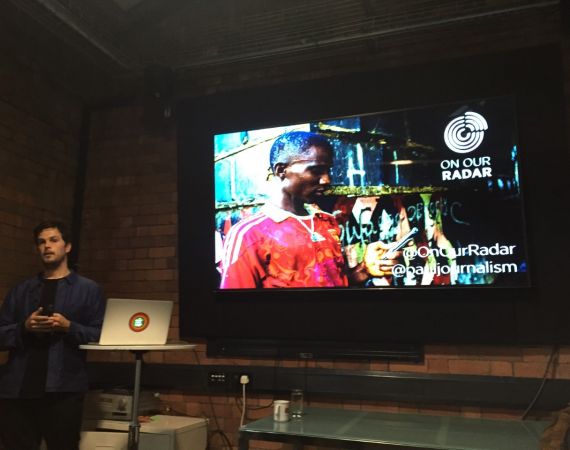Lunchtime talk write-up
Posted on Thu 11 Feb 2016
Using simple tech to enable digital storytelling from remote or offline communities
We were really lucky to be joined by Paul Myles on Friday 5 February, the Editorial and Engagement Manager of On Our Radar.

Posted by
We were really lucky to be joined by Paul Myles on Friday 5 February, the Editorial and Engagement Manager of On Our Radar. The organisation is made up of a small team of journalists, digital storytellers and technologists who work together to provide services to remote and marginalised offline communities that empowers individuals to become reporters and equips them with the tools to join the conversation surrounding current events and provide personal insight, where they may otherwise feel unheard and unconnected.
Here are 5 things I learned during the talk:
1. The work of On Our Radar and the communities they engage with can heighten the integrity of reporting and instils confidence in reporters.
On Our Radar have worked with many communities all over the world that may be under-represented in mainstream media, including the homeless in the UK, labour activists in India, and those in Kenya and Nigeria during elections. On Our Radar produce low-tech customised microsites to host the information coming from these communities, giving back the integrity and authorship to the affected individuals. To equip reporters, they organise workshops that offer skills and training to allow individuals to have independence. In instances such as their UK homelessness project, Mobile Lives, they found that giving homeless reporters this independence ensured the reporting was honest and authentic, as the community had lost faith in traditional reporting techniques for fear of being misquoted and misrepresented.
2. Even the most remote communities typically have access to at least a basic mobile phone, and are therefore able to share digital media.
In a project about the Ebola crisis in Sierra Leone, On Our Radar realised that the communities they tend to work with rarely have access to wifi, so they developed an SMS hub to be able to develop stories with offline communities at the cost of a local message. This allows them to reach communities that are typically excluded from the digital conversation. For those with smartphones, they trialled whatsapp groups to develop stories, using the photo, text and audio functions. On Our Radar reach out to people in polio camps, urban slums etc – the places often forgotten about or washed over in Western media, and were able to accurately track the country’s recovery process.
3. On Our Radar works not only with grassroots communities, but also media giants.
The organisation has worked with Aljazeera, BBC World Service, Guardian and Sky to name a few. There seems to be a mutual benefit in attaching strong, diverse, first-hand voices in telling a story, as it perhaps adds a credibility that is so often lost in biased mainstream media.
4. There are over 100 forms of dementia.
On Our Radar are currently running a UK-based project called Dementia Diaries which empowers sufferers to be able to share their stories and experiences of dealing with the disorder – which has over 100 forms and impacts many Britons in a variety of ways. On Our Radar’s reporters have contributed to the Buzzfeed articles '8 Uplifting Tales of Coping With Dementia’ and '16 Things You Didn’t Know Happened in Dementia'. They also did a digital feature with Dementia Friends titled 'Door into Dementia' which mimicked an advent calendar format and supplied an intuitive platform to access the stories.
5. If the tech is too complicated – you can always design your own!
During the Dementia Diaries project, it became clear that sufferers were increasingly unlikely to be familiar with digital formats - due to the condition predominantly affecting elder individuals. To combat this issue, they worked with 3D printing company OwnPhone to create simple, user-tested technology that would have some semblance of a landline phone. The phone has a ‘report’ button, which when pressed, contacts an answer phone service where users can leave messages and stories.
